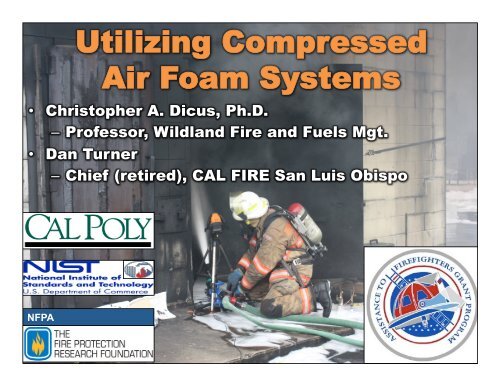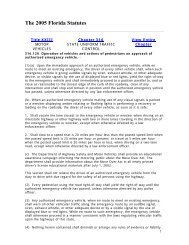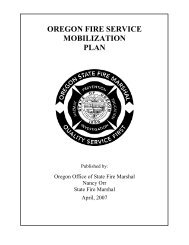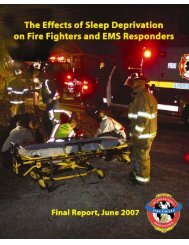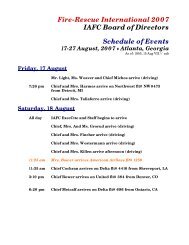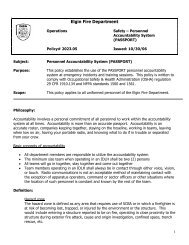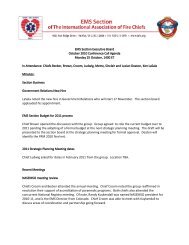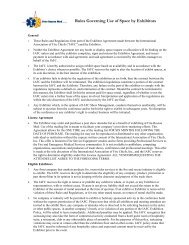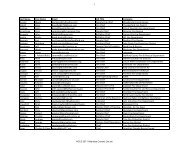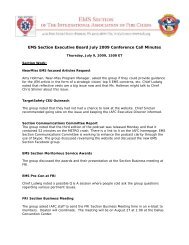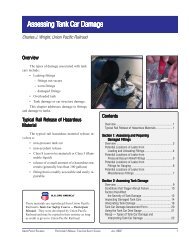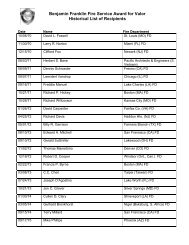Utilizing Compressed Air Foam Systems (CAFS)
Utilizing Compressed Air Foam Systems (CAFS)
Utilizing Compressed Air Foam Systems (CAFS)
Create successful ePaper yourself
Turn your PDF publications into a flip-book with our unique Google optimized e-Paper software.
<strong>Utilizing</strong> <strong>Compressed</strong><br />
<strong>Air</strong> <strong>Foam</strong> <strong>Systems</strong><br />
• Christopher A. Dicus, Ph.D.<br />
– Professor, Wildland Fire and Fuels Mgt.<br />
• Dan Turner<br />
– Chief (retired), CAL FIRE San Luis Obispo<br />
NFPA
<strong>Compressed</strong> <strong>Air</strong> <strong>Foam</strong><br />
Heaven-‐sent or Devil Incarnate??? <br />
Do you call 911 because you need <br />
<strong>CAFS</strong> or because you have it???
The good, the bad, and the unknown…<br />
• Yea!!!<br />
– Less water needed<br />
– More effective???<br />
• Deeper penetration<br />
• Longer lasting<br />
• Fewer rekindles<br />
– Less personnel needed???<br />
The confused…!<br />
• Boo!!!<br />
– More dangerous???<br />
• Firefighter slippage<br />
• Hose kinking<br />
• Nozzle reaction<br />
• <strong>Foam</strong> separation<br />
– “I’m spraying nothing but air<br />
here!!!”<br />
• Splashback<br />
• Interferes with investigations<br />
– Less personnel needed???
Overall Purpose…<br />
• Scientifically test the effectiveness and<br />
FIREFIGHTER SAFETY considerations of:<br />
– <strong>CAFS</strong> vs. Water<br />
• Straight bore vs. fog nozzles<br />
– Two types of testing…<br />
• Large-scale enclosure fire tests<br />
– Gas cooling<br />
– Knockdown<br />
• Fire ground evolutions<br />
– Nozzle reaction forces<br />
– Hose line kinking<br />
– Slippage<br />
– Stream throw and distribution<br />
– <strong>Foam</strong> separation
Why Cal Poly???<br />
• WUI fires occur on campus<br />
• The ONLY University with interdisciplinary<br />
Collaboration in Fire Mgt. with the following nationally<br />
recognized programs<br />
• Fire Protection Engineering Masters Degree<br />
• Forestry & Natural Resources Major<br />
• Wildland Fire & Fuels<br />
• City & Regional Planning Department<br />
2005 Horse Canyon Fire
Seeking input…<br />
• Stakeholder group meets Dec-2011<br />
– Fire agencies:<br />
• Texas, Arizona, Montana, N.<br />
Carolina, California, Michigan,<br />
New Hampshire, Tennessee,<br />
Virginia, Wash DC, Montreal<br />
• Organizations:<br />
– IAFC, IAFF, NVFC, AFG, ISO, ICMA,<br />
NVFC, ISFSI, NRC Canada<br />
• Outcomes<br />
– Background talks<br />
– Demonstrations<br />
– Breakout groups<br />
– RESEARCH PLAN<br />
• PRIORITY ON<br />
FIREFIGHTER<br />
SAFETY!!!
1. Fire Suppression<br />
Experiments<br />
• Objective:<br />
– Evaluate <strong>CAFS</strong> vs. water (and<br />
differing nozzle types for interior<br />
structural firefighting<br />
• Approach:<br />
– Real scale, instrumented fire<br />
suppression experiments<br />
– Unbiased scientific rigor<br />
• Three types of experiments<br />
– Spray distribution<br />
– Gas cooling<br />
– Interior attack with “real fuels”<br />
• Led by NIST<br />
– Dr. Dan Madrzykowski et al.
Fire Suppression Experiments<br />
Building for Gas Cooling<br />
Experiments<br />
Buildings for Fire<br />
Suppression Experiments<br />
Delaware County (PA) Emergency Services Training Center (enter at your own risk…)
Configuration<br />
• Nozzles:<br />
– Task Force Tips – Metro 1, Fixed<br />
Gallonage<br />
• Straight Stream<br />
• 30 degree Fog<br />
– Metro 1 with 7/8 inch Smooth Bore<br />
(SB)<br />
• Flow:<br />
– Water: 120 gpm<br />
– <strong>CAFS</strong>: 120 gpm water/60 cfm air<br />
• 1-3/4 inch hose
“Well, why don’t you just…”<br />
The Experiments<br />
• 12 Gas Cooling Experiments<br />
– 4 Water SS from room<br />
– 2 Water Fog from room<br />
– 1 Water SB from room<br />
– 2 Water SS from Hall<br />
– 2 Water Fog from Hall<br />
– 1 Water SB from Hall<br />
LOTS of work and data..<br />
• 21 Suppression Experiments<br />
– 5 Water Straight Stream (SS)<br />
– 4 Water Fog<br />
– 2 Water Solid<br />
– 3 CAF SS<br />
– 3 CAF Fog<br />
– 4 CAF Solid
Distribution Testing Video
The<br />
more<br />
things<br />
change…
Distribution…<br />
Straight Stream -‐ Water <br />
15.0 <br />
10.0 <br />
5.0 <br />
0.0 <br />
0.6 1.1 1.7 2.2 2.8 3.3 3.9 <br />
Meters Wide (m) <br />
Straight Stream -‐ <strong>CAFS</strong> <br />
5.55.0 <br />
4.4 <br />
3.9 <br />
3.3 <br />
2.8 0.0 <br />
2.2 <br />
1.7 <br />
1.1 0.6 2.8 3.3 3.9 <br />
0.6 1.1 1.7 2.2 <br />
Meters Wide (m) <br />
Mass of Water Collected (kg) <br />
14.0 <br />
12.0 <br />
10.0 <br />
8.0 <br />
6.0 <br />
4.0 <br />
2.0 <br />
Mass of Water Collected (kg) <br />
SPll interprePng the <br />
pracPcal side of results… <br />
Fog Stream -‐ <strong>CAFS</strong> <br />
5.5 4.4 3.3 <br />
2.2 <br />
1.1 <br />
0.0 <br />
0.6 <br />
1.1 <br />
1.7 <br />
2.2 2.8 3.3 3.9 <br />
Meters Wide (m) <br />
Enabled placing <br />
thermocouples out of main <br />
flow of agents <br />
14.0 <br />
12.0 <br />
10.0 <br />
8.0 <br />
6.0 <br />
4.0 <br />
2.0 <br />
Mass of Water Collected (kg)
Gas Cooling<br />
Fire Room<br />
Fire Room<br />
Smoke Room
Thermal imaging
Gas Cooling Video
Science is not always<br />
an adrenaline rush…
Not a big difference<br />
450 <br />
Water Solid 7/8 , 120 <br />
CAF Solid Stream 7/8, 120/60 <br />
450 <br />
Temperature C <br />
400 <br />
350 <br />
300 <br />
250 <br />
GC1_0-‐3mBC <br />
GC1_0-‐91mBC <br />
GC3_0-‐3mBC <br />
GC3_0-‐91mBC <br />
Temperature C <br />
400 <br />
350 <br />
300 <br />
250 <br />
GC1_0-‐3mBC <br />
GC1_0-‐91mBC <br />
GC3_0-‐3mBC <br />
GC3_0-‐91mBC <br />
200 <br />
2400 2900 <br />
Time (s) <br />
200 <br />
5800 6300 <br />
Time (s)
Knockdown<br />
Experiments
Instrumentation
Knockdown Video
Big (and<br />
different)<br />
messes…
Making<br />
the<br />
system<br />
work for<br />
you…
Temperature C <br />
Temperature C <br />
1000 <br />
500 <br />
0 <br />
1000 <br />
800 <br />
600 <br />
400 <br />
200 <br />
0 <br />
Test 1 -‐ CAF, Fog, TC Array 1 <br />
0 200 400 <br />
Time (s) <br />
Test 2 -‐ Water, Fog, TC Array 1 <br />
0 200 400 <br />
Time (s) <br />
FSE1_0-‐03mBC <br />
FSE1_0-‐3mBC <br />
FSE1_0-‐61mBC <br />
FSE1_0-‐91mBC <br />
FSE1_1-‐22mBC <br />
FSE1_1-‐52mBC <br />
FSE1_1-‐83mBC <br />
FSE1_2-‐13mBC <br />
FSW1_0-‐03mBC <br />
FSW1_0-‐3mBC <br />
FSW1_0-‐61mBC <br />
FSW1_0-‐91mBC <br />
FSW1_1-‐22mBC <br />
FSW1_1-‐22mBC <br />
FSW1_1-‐52mBC <br />
FSW1_1-‐83mBC <br />
FSW1_2-‐13mBC <br />
Similar results<br />
• Both knocked<br />
down fire<br />
– Taking a gun to<br />
a knife fight???<br />
• Both rekindled<br />
– Realistic<br />
operations???
Let’s start a<br />
gun fight…<br />
• Results<br />
warrants new<br />
tests this May
2. Clearing up fireground<br />
evolution questions…
Additional Automatic Nozzle Tested<br />
• Elkhart Select-O-Matic<br />
automatic combination<br />
nozzle<br />
• 60-200 GPM
Apparatus<br />
• Pierce apparatus<br />
• Waterous pump<br />
• <strong>Foam</strong> Pro <strong>CAFS</strong> system<br />
• In line flow meter<br />
• 100 ft of 1-3/4 inch hose
Nozzle Reaction Forces
Nozzle in fixed <br />
frame device <br />
Test Device<br />
Digital recording scale
Nozzle Reaction Forces<br />
1-1/4” Smooth bore nozzle<br />
<strong>CAFS</strong> <br />
Water
Nozzle Reaction Forces<br />
15/16” Automatic Combo nozzle
<strong>CAFS</strong> 15/16” Auto Combo nozzle vs. 1-1/4” smooth<br />
Bore<br />
1-1/4 in. Nozzle
<strong>CAFS</strong> 15/16” Combination nozzle vs.<br />
1-1/4” Smooth Bore<br />
1-1/4 in. Nozzle
Throw and Distribution Tests<br />
DistribuPon <br />
Throw
Throw and<br />
Distribution<br />
12 <br />
6 <br />
0 <br />
6 <br />
12 <br />
0 10 20 30 40 50 60 70 80 90 100 110 120 130 140 150 160
Test grid video
<strong>CAFS</strong> @ 120 GPM <br />
Water vs. <strong>CAFS</strong><br />
Distance…<br />
Same pump<br />
pressure<br />
• <strong>CAFS</strong><br />
H 2 O @ 120 GPM <br />
• Water
Throw and Distribution –<br />
Max. throw distance
Flow Distribution<br />
<strong>CAFS</strong> Water
Hose Kinking<br />
• Anecdotal evidence<br />
that <strong>CAFS</strong>-filled<br />
hoses more likely to<br />
kink than waterfilled<br />
hoses
Hose<br />
Kinking<br />
F
Hose Kinking – Static Conditions
Hose Kinking – Flow Conditions
Preliminary findings from fire<br />
ground evolutions<br />
• Nozzle reaction is generally higher with <strong>CAFS</strong><br />
• <strong>CAFS</strong> has greater throw than water at same<br />
pressures<br />
– Distribution is more compact at distance<br />
• Hose kinkage<br />
– <strong>CAFS</strong> easier to kink when static<br />
– <strong>CAFS</strong> harder to kink when flowing<br />
• Red Solo cups are “marginal for fluid capture<br />
measurements”
Friction Testing – Surfaces tested<br />
• Slip/Friction testing<br />
– Dry surface<br />
– Wet (water)<br />
– Wet (foam solution at<br />
0.3%)<br />
– Submerged ¼ in (water)<br />
– Submerged ¼ in (foam<br />
solution at 0.3%)
Upcoming Tests –<br />
Flow Separation/Stratification<br />
• Potential factors<br />
– Height of column<br />
– Time<br />
<strong>Air</strong> <br />
<strong>Foam</strong> <br />
– Concentration<br />
– Mixture ratio<br />
– Horizontal and<br />
vertical<br />
– Time to reestablish<br />
<strong>CAFS</strong> flow<br />
Water
Future<br />
Questions…<br />
• Hose Burst<br />
• Splashback<br />
• Environmental<br />
concerns<br />
• Acquired structures<br />
• Others???
Thanks!!!


